Complete Solutions to EXERCISE - II (C.W)(OBJECTS SUSPENDED BY STRINGS AND APPARENT WEIGHT) of chapter LAW OF MOTION of Class 11 book with complete answers and questions
| Class 11 | PHYSICS |
| Chapter | LAW OF MOTION |
| NARAYANA | EXERCISE - II (C.W)(OBJECTS SUSPENDED BY STRINGS AND APPARENT WEIGHT) |
| Number Of Questions | 21 |
| Academic Year | 2023-24 |
The block is placed on a frictionless surface in gravity free space. A heavy string of a mass m is connected and force F is applied on the string, then the tension at the middle of rope is

View SolutionA ball is suspended by a thread from the ceiling of a tram car. The brakes are applied and the speed of the car changes uniformly from `36 kmh^(-1)` to zero in 5 s. The angle by which the ball deviates from the vertical is `(g=10 ms^(-2))`
View SolutionA block is kept on a frictionless inclined surface with angle of inclination `alpha`. The incline is given an acceleration ‘a’ to keep the block stationary. Then 'a' is equal to
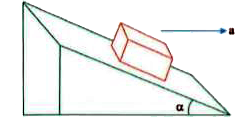
View SolutionA man sits on a chair supported by a rope passing over a frictionless fixed pulley. The man who weighs 1,000 N exerts a force of 450 N on the chair downwards while pulling the rope on the other side. If the chair weighs 250N, then the acceleration of the chair is
View SolutionA balloon of mass M is descending at a constant acceleration `alpha`. When a mass m is released from the balloon it starts rising with the same acceleration `alpha` . Assuming that its volume does not change, what is the value of m?
View SolutionA monkey of mass 40 kg climbs on a massless rope of breaking strength 600 N. The rope will break if the monkey. (Take `g=10 m//s^(2)`)
View SolutionTwo persons are holding a rope of negligible weight tightly at its ends so that it is horizontal. A 15 kg weight is attached to rope at the midpoint which now no more remains horizontal. The minimum tension required to completely straighten the rope is
View SolutionA straight rope of length 'L' is kept on a frictionless horizontal surface and a force 'F' is applied to one end of the rope in the direction of its length and away from that end. The tension in the rope at a distance 'l' from that end is
View SolutionConsider three blocks of masses `m_(1), m_(2), m_(3)` interconnected by strings which are pulled by a common force F on a frictionless horizontal table as in the figure. The tension `T_(1) and T_(2)` are also indicated

a) `T_(2) gt T_(1)" if "m_(2) gt m_(1)`
b) `T_(2) =T_(1)" if "m_(2)=m_(1)`
c) `T_(2) gt T_(1)` always
d) `"acceleration of the system"=(F)/(m_(1)+m_(2)+m_(3))`
View SolutionA railway engine of mass 50 tons is pulling a wagon of mass 40 tons with a force of 4500N. The resistance force acting is 1N per ton. The tension in the coupling between the engine and the wagon is
View SolutionIn the following figure, the pulley is massless and frictionless. There is no friction between the body and the floor. The acceleration produced in the body when it is displaced through a certain distance with force 'P' will be

View SolutionTwo identical blocks each of mass ''M'' are tied to the ends of a string and the string is laid over a smooth fixed pulley. Initially the masses are held at rest at the same level. What fraction of mass must be removed from one block and added to the other, so that it has an acceleration of `1//5^("th")` of the acceleration due to gravity
View SolutionIn the given arrangement, n number of equal masses are connected by strings of negligible masses. The tension in the string connected to `n^("th")` mass is :
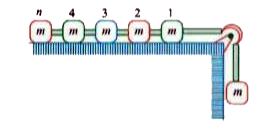
View SolutionA 40 N block is supported by two ropes. One rope is horizontal and the other makes an angle of `30^(@)` with the ceiling. The tension in the rope attached to the ceiling is approximately :
View SolutionThe pulley arrangements shown in figure are identical, the mass of the rope being negligible. In case I, the mass m is lifted by attaching a mass 2m to the other end of rope with a constant downward force F = 2mg, where g is acceleration due to gravity. The acceleration of mass m in case I is
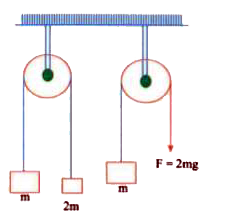
View SolutionTwo masses of 10 kg and 5 kg are suspended from a rigid support as shown in figure. The system is pulled down with a force of 150 N attached to the lower mass. The string attached to the support breaks and the system accelerates downwards.
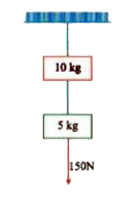
In case the force continues to act. what will be the tension acting between the two masses ?
View SolutionTwo bodies of masses 3kg and 2kg are connected by a long string and the string is made to pass over a smooth fixed pulley. Initially the bodies are held at the same level and released from rest. The velocity of the 3kg body after one second is `(g=10m/s^(2))`
View SolutionA block of mass 3kg which is on a smooth inclined plane making an angie of `30^(@)` to the horizontal is connected by cord passing over light frictionless pulley to second block of mass 2kg hanging vertically. What is the acceleration of each block and what is the tension of the cord ?
View SolutionIf `m_(1) = 10kg, m_(2)= 4kg, m_(3)= 2kg`, the acceleration of system is
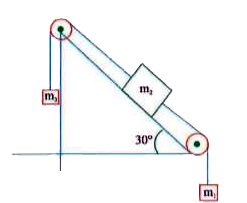
View SolutionThe string between blocks of masses 'm' and '2m' is massless and inextensible.The system is suspended by a massless spring as shown. If the string is cut, the magnitudes of accelerations of masses 2m and m (immediately after cutting)
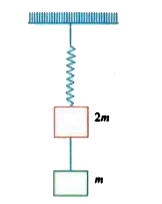
View SolutionAll surfaces are smooth. The acceleration of mass m relative to the wedge is
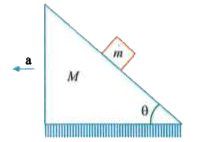
View Solution
EXERCISE - II (C.W)(OBJECTS SUSPENDED BY STRINGS AND APPARENT WEIGHT) questions and complete solutions for chapter LAW OF MOTION of NARAYANA PHYSICS (HINGLISH) of Class 11
All Exercises from NARAYANA Class 11 PHYSICS LAW OF MOTION
- C.U.Q
- EVALUATE YOURSELF - 1
- EVALUATE YOURSELF - 2
- EVALUATE YOURSELF - 3
- EVALUATE YOURSELF - 4
- EVALUATE YOURSELF - 5
- EXERCISE - I (C.W)(EQUILIBRIUM OF A PARTICLE)
- EXERCISE - I (C.W)(IMPULSE)
- EXERCISE - I (C.W)(LAW OF CONSERVATION OF MOMENTUM)
- EXERCISE - I (C.W)(LAWS OF FRICTION)
- EXERCISE - I (C.W)(MOTION OF A BODY ON THE INCLINED PLANE)
- EXERCISE - I (C.W)(MOTION ON A HORIZONTAL ROUGH SURFACE)
- EXERCISE - I (C.W)(NEWTON.S LAWS OF MOTION)
- EXERCISE - I (C.W)(OBJECTS SUSTENDED BY STRINGS & APPARENT WEIGHT)
- EXERCISE - I (C.W)(PULLING/PUSHING A BODY)
- EXERCISE - I (C.W)(UNIFORM CIRCULAR MOTION)
- EXERCISE - I (H.W)(CIRCULAR MOTION)
- EXERCISE - I (H.W)(IMPULSE)
- EXERCISE - I (H.W)(LAW OF CONSERVATION OF MOMENTUM)
- EXERCISE - I (H.W)(LAWS OF FRICTION)
- EXERCISE - I (H.W)(MOTION OF A BODY ON THE INCLINED PLANE)
- EXERCISE - I (H.W)(MOTION ON A HORIZONTAL ROUGH SURFACE)
- EXERCISE - I (H.W)(NEWTON.S LAWS OF MOTION)
- EXERCISE - I (H.W)(OBJECTS SUSTENDED BY STRINGS & APPARENT WEIGHT)
- EXERCISE - II (C.W)(CIRCULAR MOTION)
- EXERCISE - II (C.W)(EQUILIBRIUM OF A PARTICLE)
- EXERCISE - II (C.W)(IMPULSE)
- EXERCISE - II (C.W)(LAW OF CONSERVATION OF MOMENTUM)
- EXERCISE - II (C.W)(MOTION OF BODY ON THE INCLINED PLANE)
- EXERCISE - II (C.W)(MOTION ON A HORIZONTAL ROUGH SURFACE)
- EXERCISE - II (C.W)(NEWTON.S LAWS OF MOTION)
- EXERCISE - II (C.W)(OBJECTS SUSPENDED BY STRINGS AND APPARENT WEIGHT)
- EXERCISE - II (C.W)(PULLING/PUSHING A BODY)
- EXERCISE - II (H.W)(CIRCULAR MOTION)
- EXERCISE - II (H.W)(MOTION OF A BODY ON THE INCLINED PLANE)
- EXERCISE - II (H.W)(MOTION ON A HORIZONTAL ROUGH SURFACE)
- EXERCISE - II (H.W)(NEWTON.S LAWS OF MOTION)
- EXERCISE - II (H.W)(OBJECTS SUSPENDED BY STRINGS AND APPARENT WEIGHT)
- EXERCISE - II (H.W)(PULLING/PUSHING A BODY)
- EXERCISE - III
- EXERCISE - IV
- Illustration